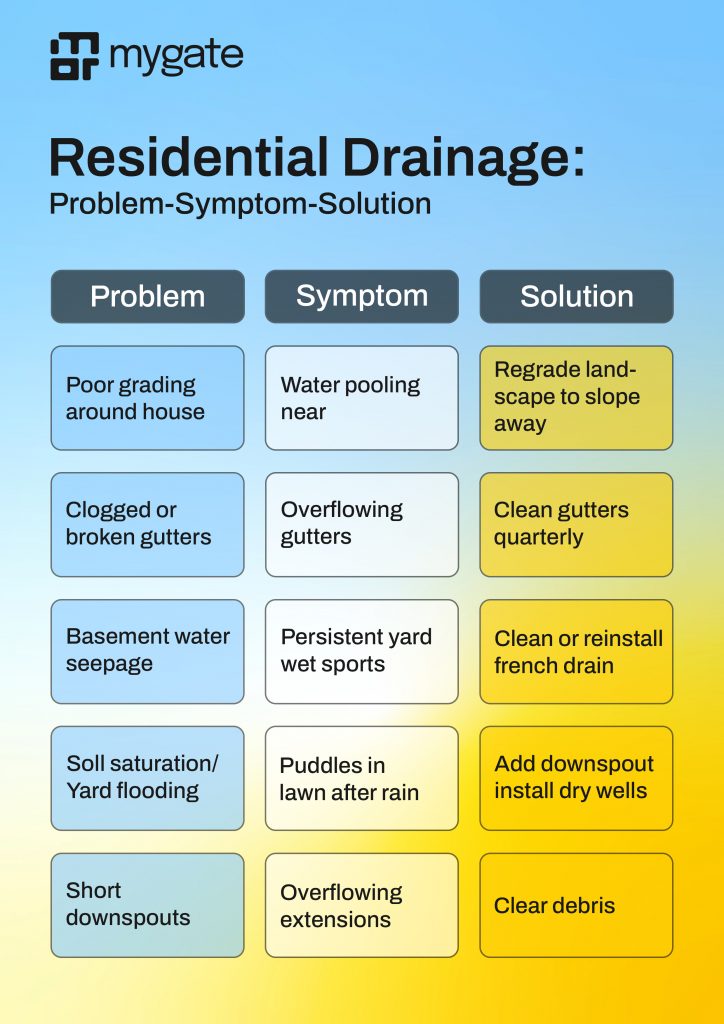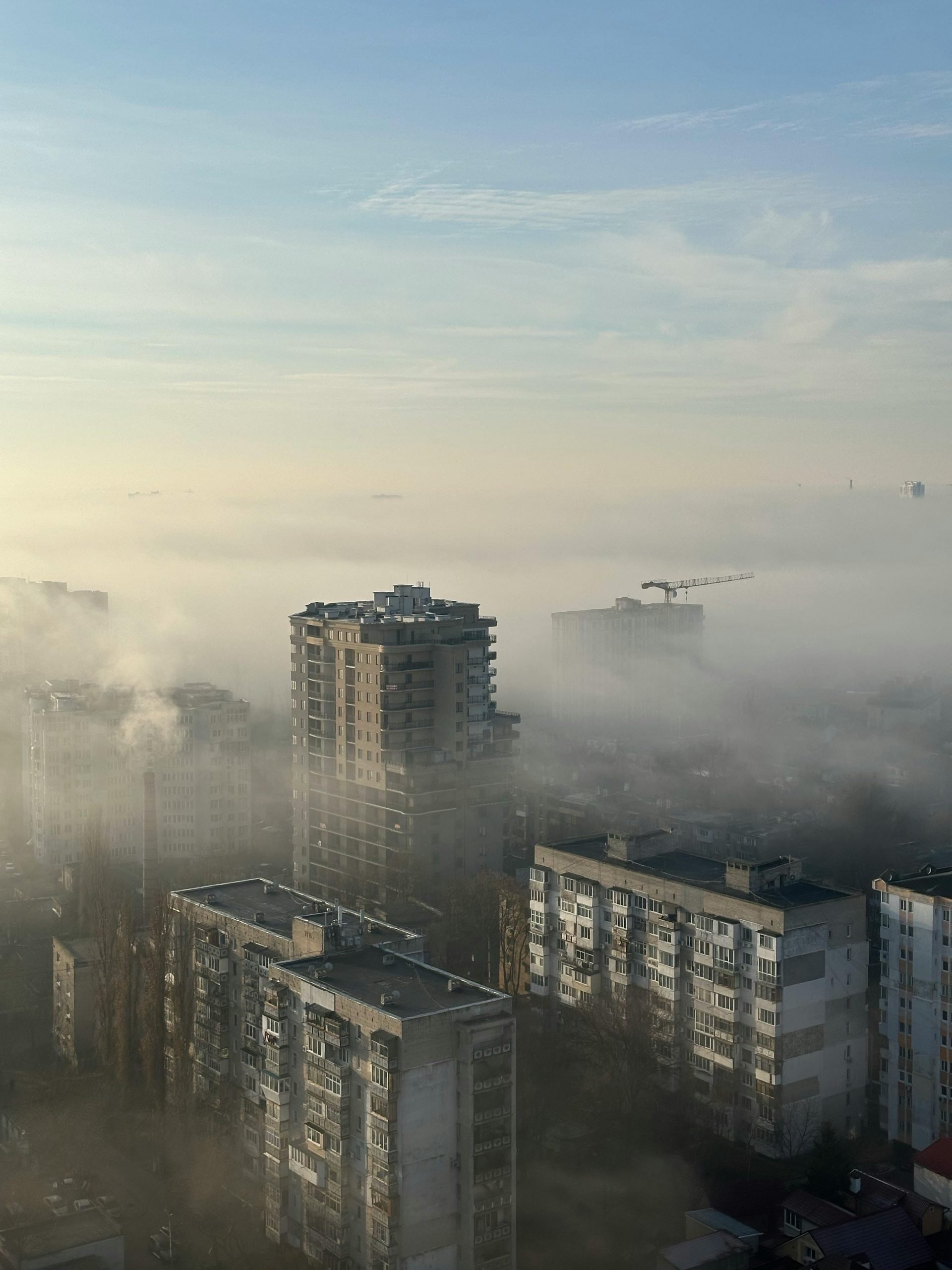Drainage problems often start with small puddles but can quickly escalate into basement floods, foundation damage, mold, and costly repairs. Common causes include poor grading, clogged gutters, failed French drains, and heavy clay soil. Fixing grading, upgrading gutter systems, installing proper French drains or sump pumps, and improving soil are proven solutions. Regular maintenance and professional help (when needed) are essential to prevent disasters and protect your home’s value.
Drainage issues start small. Maybe you notice a puddle that doesn’t dry up after rain. Then your basement smells musty. Before you know it, you’re dealing with foundation cracks and mold problems that cost serious money to fix.
Table of Contents
Introduction
Last month, my neighbor’s basement flooded again. Third time this year. She keeps mopping up water and hoping it’ll stop, but the real problem is outside – water has nowhere to go. We’ve seen this story play out dozens of times in our neighborhood.
Drainage issues start small. Maybe you notice a puddle that doesn’t dry up after rain. Then your basement smells musty. Before you know it, you’re dealing with foundation cracks and mold problems that cost serious money to fix.
Why proper drainage matters in residential areas
Your home’s drainage system isn’t just about avoiding puddles. Good drainage keeps your property value up. Houses with water problems sell for less – buyers can smell trouble from a mile away. Plus, standing water breeds mosquitoes and creates perfect conditions for mold growth. Nobody wants their kids playing in a yard that turns into a swamp after every storm.
Then there’s the legal side. More cities are cracking down on stormwater runoff. Your drainage problems can become your neighbor’s drainage problems, and that leads to disputes nobody wants.
Top residential drainage system problems
1. Poor grading around the house
Walk around after a good rain and you’ll spot the trouble areas. Water sitting against your house foundation? That’s bad news waiting to happen. This happens usually because whoever did the original grading didn’t think it through, or the ground has settled over time.
2. Clogged or broken gutters and downspouts
Overflowing gutters are like having no gutters at all. Water cascades down your walls, stains the paint, and dumps right where you don’t want it. Most of the time it’s leaves and debris, but sometimes the gutters are just too small for heavy storms.
3. French drain failure
These underground drainage systems work great when they’re new. Five years later? Roots grow into the pipes, debris clogs everything up, and suddenly your “fixed” drainage problem is back worse than before.
4. Basement water seepage
That musty smell isn’t just unpleasant – it’s expensive. Water finds its way through foundation walls when the soil outside gets saturated. You’ll see white chalky deposits on your basement walls, rust on metal fixtures, and eventually actual puddles on your floor.
5. Soil saturation and yard flooding
Some properties just don’t drain naturally. Heavy clay soil holds onto water like a sponge. Low spots collect runoff from higher areas. Your grass dies, your landscaping suffers, and your yard becomes unusable for days after storms.
Warning signs of drainage issues
- Water stains on foundation walls tell a story. Even if they fade during dry weather, they’re warning signs of bigger problems coming. I always tell people to take pictures of these stains so they can track whether things are getting worse.
- Cracks in walls or floors that keep getting bigger usually mean your foundation is moving. Water damage causes this kind of structural shifting, and it doesn’t fix itself.
- Mold and mildew smells in basements are dead giveaways. Once you’ve got moisture problems, mold follows quickly. This stuff affects your family’s health and makes your house basically unsellable.
- Mosquitoes breeding around your property means you’ve got standing water somewhere. Even tiny amounts in hidden spots can support huge mosquito populations.
- Dead patches in your lawn despite regular watering and fertilizing usually indicate drainage problems underground. Waterlogged roots can’t get oxygen and die off.
Best solutions for common drainage problems

1. Fix your grading first
Your ground needs to slope away from your house – at least 6 inches over the first 10 feet. Sounds simple, but it requires bringing in the right kind of soil and shaping everything properly. Investing in proper grading now can prevent thousands in future repairs. Proper grading prevents way more expensive problems later. I’ve seen people spend hundreds on grading to avoid thousands in foundation repairs.
2. Upgrade your gutter system
Standard residential gutters often fail during today’s increasingly intense rainstorms. Go bigger if you’re replacing them. Add leaf guards to reduce maintenance headaches. Most importantly, make sure your downspouts dump water at least 6 feet from your foundation.It is always recommend getting your gutters professionally installed with the right slope toward downspouts. DIY gutter work often creates more problems than it solves.
3. French drain installation or repair
When installed correctly, French drains work for decades. The key is proper depth – usually 18-24 inches and using the right materials. Filter fabric prevents soil from clogging the system while still allowing water flow. Most failures come from cutting corners during installation. Proper pipe sizing, adequate gravel, and correct slope make all the difference.
4. Sump pump installation
If your basement floods regularly, you need a sump pump with battery backup. Power outages often happen during storms when you need pumps most. Get this professionally installed. Proper pit sizing and electrical work aren’t DIY projects. Regular maintenance includes testing the pump and keeping discharge pipes clear.
5. Soil aeration and dry wells
Clay-heavy soil causes drainage problems by holding onto water. Core aeration helps by creating channels for water and air movement. It’s not glamorous work, but it makes a real difference. Dry wells work in some situations, they collect stormwater and release it slowly into surrounding soil. These need adequate space away from your foundation and septic systems.
When to call a professional
- Some warning signs mean stop messing around and call experts immediately. Foundation shifts, new wall cracks, or doors and windows that suddenly don’t close properly indicate serious structural problems.
- Large areas of standing water that persist for days after storms usually require systematic solutions beyond DIY capabilities. I’ve watched homeowners throw money at temporary fixes while ignoring the real underlying issues.
- If you’ve tried multiple solutions and problems keep getting worse, professional assessment becomes essential. Experienced contractors spot root causes that aren’t obvious to homeowners.
Preventive maintenance tips
- Clean your gutters every three months, more often if you have lots of trees. This simple maintenance prevents most overflow problems.
- Check your grading annually, especially after heavy rain seasons or major landscaping work. Look for areas where soil has settled or erosion has changed drainage patterns.
- Make sure downspouts stay extended away from your house. These extensions get moved during lawn maintenance and forgotten.
- Rain barrels help reduce system burden during heavy storms while giving you water for dry periods. Native plants that tolerate wet conditions absorb excess water while looking good.
FAQs
Water pooling near your foundation, basement moisture, overflowing gutters, soggy yard areas, foundation cracks, and musty basement odors are clear warning signs.
Simple stuff like cleaning gutters, extending downspouts, and minor grading work are fine for DIY. Complex problems involving foundations, major regrading, or French drain installation need professional expertise.
Late spring and early summer provide ideal conditions for drainage work before heavy rainfall seasons. Emergency repairs should be addressed immediately regardless of timing.
Conclusion
Taking care of drainage problems before they become disasters saves enormous amounts of money and stress. Prevention costs way less than repairs after water damage occurs.
Regular attention and occasional updates keep drainage systems working as your landscaping matures and weather patterns change. When problems exceed your capabilities, getting professional help quickly prevents thousands in future repair costs.


